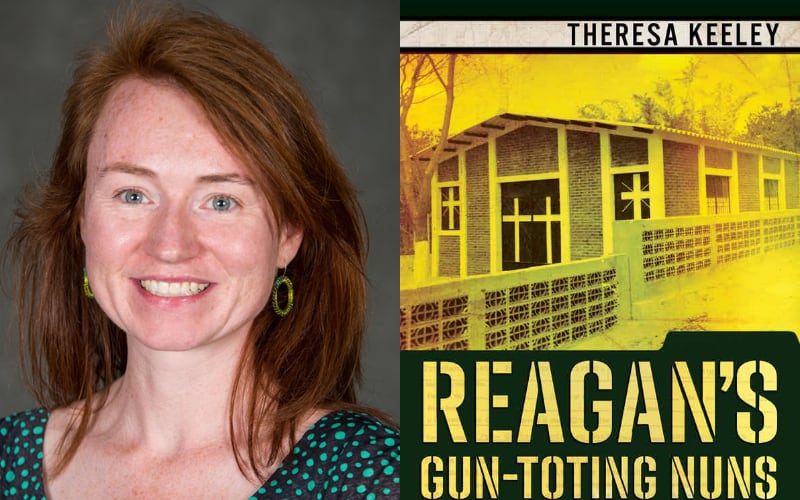Theresa Keeley was awarded the 2021 John Gilmary Shea Prize for her book Reagan’s Gun-Toting Nuns: The Catholic Conflict Over Cold War Human Rights Policy in Central America (Cornell University Press.) The Shea Prize honors a book that has made the most “original and distinguished contribution” to the history of the Catholic Church. It carries a purse of $1,500.
Keeley was a guest earlier this month on New Books in Catholic Studies podcast, where she spoke about the book with Allison Isadore.
The prize committee writes:
“The ACHA’s committee on the John Gilmary Shea Prize (A. Katie Stirling-Harris [chair], Massimo Faggioli, and John Seitz) is pleased to recommend as the 2020 recipient Theresa Keeley’s Reagan’s Gun-Toting Nuns: The Catholic Conflict Over Cold War Human Rights Policy in Central America (Ithaca: Cornell University Press, 2020). This gripping book focuses in a Catholic-driven rightward turn in American foreign policy in the late 1970s and into the 1980s that aided and abetted repressive governments and death squads in Guatemala, Nicaragua, and El Salvador that killed thousands. Keeley documents the ways conservative and traditionalist U.S. Catholics in the post-Vatican II era had an outsized impact on foreign policy, especially during Reagan’s first term (1980-84). These anticommunist Catholics saw an opportunity in foreign policy and human rights discussions to advance a battle being fought within the church between leftists informed by liberation theology and “true Catholicism” rooted in individual liberty and ostensibly apolitical personal spirituality. Aligning with Protestant conservatives in a broad “post war restructuring” these Catholics offered the president a religious rationale for secret as well as explicit military and financial support of right-wing governments and their violent goons.
The haunting image on the book’s cover—a memorial chapel built in Santiago Nonualco, El Salvador at the site where the bodies of four murdered American churchwomen were found in 1980—offers a stark reminder of the heavy stakes the book lays out. The book ingeniously zeros in on the Maryknolls, a title for two orders, one for men and one for women, who began the postwar period celebrated by McCarthyites as martyrs for American anticommunism. By the 1980s, most Maryknolls had been transformed by their on-the-ground witness of the damaging effects of American foreign policy on human rights in Central America. For right-leaning Americans, the Maryknolls became a symbol of the slipping away of the Catholic Church (which had been identified with anti-Communism at least since the 1920s), the loss of alignment between American ambition and Catholic moral imaginaries. This is what made foreign policy debates so intense. When images of the four murdered churchwomen being dragged from a shallow grave were broadcast over U.S. television, the Reagan administration responded by suggesting, against all evidence, that the women had been shot while exchanging gunfire and attempting to run a military blockade. This fabrication provides the ingenious title of the book, the Reagan supporters’ conjured image of nuns wielding weapons in a misguided fight to install communism around the globe.
The book is detailed and profoundly rooted in archival research conducted in dozens of archival collections across multiple countries and continents, as well as scores of English- and Spanish-language news sources, U.S. government and particularly FBI documents, as well as Congressional records. The coverage extends past the extended debate about the fallout from the churchwomen’s murder and includes analysis of the Bush administration’s response to the 1989 execution of Jesuits, their cook, and her daughter at the Universidad Centroamericana (UCA) and the continuing terrorizing of church workers affiliated with the UCA. The U.S. approach to this atrocity, while less starkly deceptive than that of the Reagan administration, was still deeply invested in shoring up the American-friendly government rather than finding justice for the martyred advocates of the poor. Keeley is a skilled writer who threads her way through complex policy matters and offers indelible images that crystallize her argument–for example, a political cartoon published by the right-wing newpaper Washington Times that depicted Maryknoll supporting politician Tip O’Neill (a Boston Catholic) dressed in a nun’s habit while Reagan got remade as a manly Rambo.
Keeley’s book makes several significant historiographical interventions that will be of interest to a wide variety of audiences. In supporting the notion of a post-war restructuring across denominational lines, it also sheds light on contemporary ideological commitments and voting patterns shared by both white Protestants and white Catholics alike. It breaks new ground by rewriting Cold War history as a Catholic history, on not one, but both sides, and by highlighting the role of women in Cold War history, especially women religious who worked in situations of remarkable danger in defense of the poor. It also contributes to the transnationalization of Catholic history, noting the ways internal Catholic struggles exceeded national boundaries with considerable effects. In so doing, it sheds light on divergent attitudes within US Catholic circles toward Latin American Catholicism and toward Pope Francis, the first Latin American and the first Jesuit pontiff. Keely’s book also attends to Catholic aesthetics as a factor in American politics (including especially bloodied bodies and the clothing of the ordained). Perhaps most importantly, it highlights the very real influence of American power around the world and puts Catholics at the center of those decisions. The book is a remarkable achievement, clearly an original and distinguished contribution to the history of the Catholic Church.”
Thank you to the prize committee of A. Katie Stirling-Harris, University of California, Davis (chair), Massimo Faggioli, Villanova University, and John Seitz, Fordham University.

